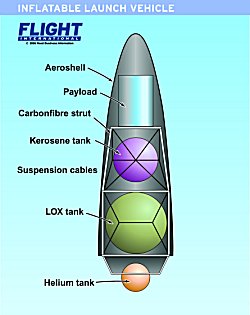An inflatable, expendable single-stage launch vehicle able to place 150kg (330lb) into low Earth orbit is being studied by University of Stuttgart’s flight dynamics institute and its spin-off controls company Astos Solutions. Currently being patented by its UK developer, the vehicle is a 20m (65ft)-high, 47t (103,000lb) rocket with inflatable Kevlar bladders with aluminium coated mylar linings suspended in a carbonfibre truss for its kerosene fuel and liquid oxygen oxidiser.

These and the payload are encased in a Kevlar, mylar-lined and helium inflated rigid aeroshell. The helium source is located at the bottom of the vehicle. “This is ideal for a Mars sample return mission. For a 10kg sample you need a 1.5t conventional vehicle. An inflatable return vehicle would only be 0.5t,” says Mohan Ahad, founder of Microlaunch Systems, the UK developer.
As well as the Astos Solutions assessment, the University of Leicester is helping with its development. Future design iterations will tackle payload deployment and a reusable version. Microlaunch Systems was the first company to receive a UK Department of Trade and Industry grant for a launcher. In 2003 it received a £30,000 ($52,600) grant for a commercial feasibility study and design work on the use of low-cost, mass-produced components.
That study included participation by the UK’s Cambridge, Leicester and Cranfield universities and Germany’s University of Stuttgart.
ROB COPPINGER / LONDON
Source: Flight International




















